Think you’re sourcing from a single factory in China?
You might be sourcing from a global network without even realizing it.
Over the past five years, many Chinese suppliers have expanded into Southeast Asia—especially Vietnam—to hedge risk, lower costs, and better serve global clients. These multi-location setups, often called factory groups, are reshaping the way brands should think about sourcing strategy.
If you’re exploring a China+1 approach or looking to diversify your supply chain, factory groups might be your fastest—and safest—path forward.
What Are Factory Groups?
Factory groups are multi-country manufacturing organizations, typically with a headquarters or origin in China, and satellite production facilities in other regions—most commonly Vietnam, Cambodia, India, or Bangladesh.
They operate under a shared brand or ownership but leverage different locations for different advantages:
- Labor cost arbitrage
- Duty-free trade access (e.g., Vietnam under EVFTA)
- Tariff avoidance
- Logistics flexibility
📌 In short: They’re already doing what most brands are trying to figure out—geographic diversification.
Why This Matters for Your Brand
✅ 1. You Might Already Have Options
If your China-based supplier is part of a factory group, they may already have a facility in Vietnam or another low-risk region. That means you could potentially shift production without starting from scratch.
All it takes is asking the right question:
“Do you operate in other countries—or have sister factories we can explore?”
✅ 2. Factory Groups Understand Brand Requirements
Unlike new suppliers, factory groups already know what you expect. They’ve seen your product line, quality standards, and order flow. This creates a smoother ramp-up if you need to pivot production.
✅ 3. They’re Built for Resilience
Factory groups often maintain shared:
- Documentation systems
- QA processes
- Supply chain partners
- Management teams
That makes transitions between countries faster, safer, and more consistent—especially compared to onboarding a new standalone factory.
✅ 4. You Can Hedge Without Duplicating Everything
Instead of managing two entirely separate vendors, factory groups allow you to build redundancy within a single relationship.
You can:
- Test production in Vietnam while continuing in China
- Benchmark pricing across locations
- Split volume across facilities as needed
This gives you the flexibility of multi-country sourcing—without the overhead of managing multiple partners.
What to Watch Out For
Not all factory groups are created equal. Ask these questions:
- Do the factories share leadership and systems—or just a name?
- Is the Vietnam facility actually equipped to make your product type?
- Can they match the same tolerances and quality levels as your China site?
- Will pricing and lead times change significantly?
At Sourcify, we vet factory groups for exactly these things. Because a logo match doesn’t always mean an operational match.
How to Leverage Factory Groups in Your Sourcing Strategy
- Start the conversation: Ask your current supplier about their full footprint.
- Audit secondary sites: Evaluate capabilities, quality, and certifications.
- Send test POs: Begin small runs to validate output and timelines.
- Track total cost: Consider freight, duties, and coordination—not just unit price.
- Plan transition timelines: Even with the same group, shifting production takes prep.
Why Sourcify Works with Factory Groups
We’ve spent years building relationships across China, Vietnam, and India. Many of the suppliers in our network are factory groups with multi-country capabilities—and we know exactly which ones can deliver consistent results across locations.
Whether you’re looking to reduce China risk or just want more flexible fulfillment options, we’ll help you find the rightsetup—not just the next one.
Related Resource:
📘 Could You Move Next Month If You Had To? — Our guide to building optionality into your supply chain.




